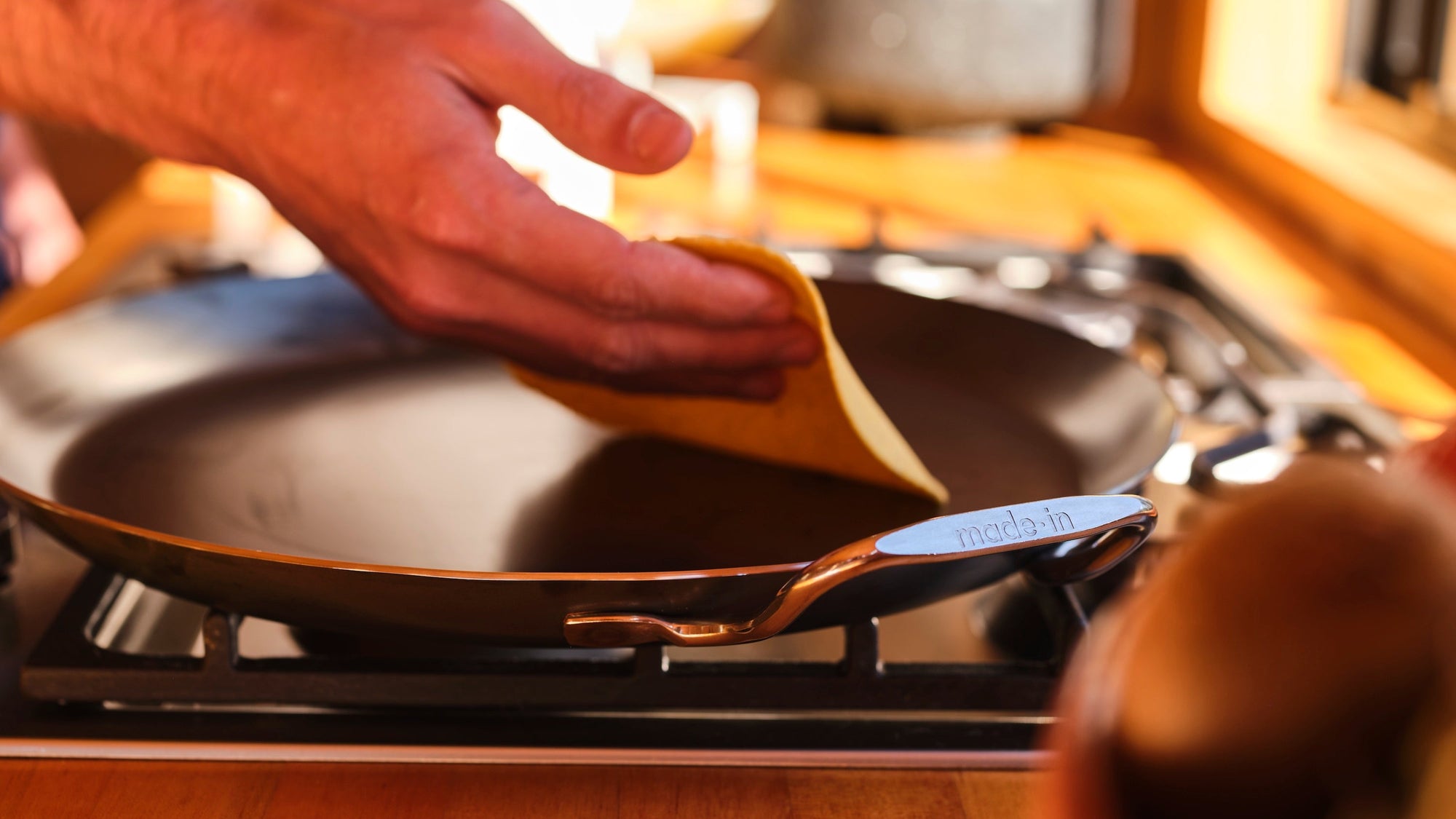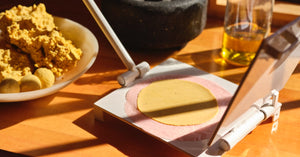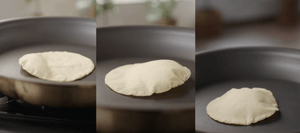Comal: An Ancient Workhorse Made New and Built to Last
Comal: An Ancient Workhorse Made New and Built to Last

September 27, 2022
Article by Andrea Aliseda
Photography by Graydon Herriott unless otherwise noted
Round, sturdy, hot — at the center of Mexican and Central American cuisine is an essential Indigenous cooking utensil, the comal. The comal, which comes from the Nahuatl word comalli (known in Venezuela as the budare), has been used since the Mesoamerican period to cook, toast, roast, blister, and puff. From the warmth of the home kitchen stove to the burners of restaurants and corner stands, whenever fire stokes this flat, round griddle, it’s a sign of the meal to come. The first comal was made of barro (traditional Mexican clay earthenware), like so many of the original cooking tools in Mesoamerican gastronomy. But over time they’ve been adapted to other materials like cast iron, copper, metal, ceramic and more, while retaining their primary shape and function. Masienda and Made In’s collaborative Comal features blue carbon steel for a sleek, lightweight take on this ancient cooking technology.
The Comal's Place in the Mexican Kitchen
The comal has origins in Mesoamerica. It can be traced back to the 6th century B.C. in Oaxaca, roughly 3,000 years ago (around the time the tortilla was first created), according to chef Maricela Vega of Chico in Atlanta, CA. Its first iterations were shaped by barro, and barro comales (like the one we sell at Masienda) are still commonly used today. Vega tells us that these sophisticated barro kitchen tools can be made in as quickly as a week, and describes the comal as, “a very accessible and central point to how we get our nourishment and heat up the most important material, the tortilla.” Barro is not exclusive to Mexico — it holds a universal connection “Every civilization created their earthenware out of clay,” Vega says. “It’s the material that’s most accessible, because it's the earth.”

Photo by Noah Forbes
NY-based chef Tony Ortiz uses a barro comal at home to cook their tortillas on, or toast them until they’re doraditos, or golden. Comales are so intrinsic to Mexican cuisine that they are a permanent fixture on stovetops, and are used daily to fire up quick quesadillas or cook a stack of fresh-made tortillas, tlacoyos, tetelas and more masa creations. They can also be used to roast, toast or scorch ingredients like tomatoes, chiles, and seeds, an instrumental step in creating dishes with more richly flavored characteristics. “I mostly use a comal to slow roast my ingredients that I will be using in more complex dishes such as moles, sauces or salsas,” says Chef Ortiz. They use their comal weekly, and say that it helps them feel connected to their family. “I grew up watching my grandmother toast or cook many food items on a comal, so it helps me feel a familiar comfort as well.”

Photo by Noah Forbes
It also connects them to their cultural identity. The comal, they say, is a “beautiful, ancient technology that we have access to. It's important for me, as a Mexican-American, to use generational technology in order to preserve my cultural history and identity.”
For Chef Vega, nourishing a relationship with the comal is empowering. “Folklore tells us that the woman was the one who would use maíz because we were the ones creating life,” she says. “We're feeding you, giving you the nourishment you need. So to me, the comal, stacks of tortillas, working with masa, period––that's empowerment. We have to have a relationship with our comal.”

Meet the Made In x Masienda Comal
The Made In x Masienda collaborative blue carbon steel is an approachable introduction to this essential Mexican technology. It’s lightweight, easy to maintain, and practically immortal. Jake Kalick of Made In shares that this special comal was created with Masienda’s specifications in mind, based on years of experience.
This blue carbon steel is imported from France, a raw material that Kalick describes as “indestructible.” Kalick explains that carbon steel is a cooking material that has been around for centuries, and is an incredibly functional piece in the kitchen that is made to last and stands up to high heat. “[Blue carbon steel is] actually 99% iron and 1% carbon,” and because it consists mostly of iron,“it can take incredibly high heat and is a great conductor of it,” Kalick elaborates. “It’s crazy durable.” He adds that this material, “is iron all the way through.”
Wondering about its color? Carbon steel is typically gray or silver, but this Made In x Masienda collaboration is blue, Kalick explains, due to “a heat treatment process we use after manufacturing that allows the iron to be protected from rust and corrosion in the process of getting the pan to you.” 
Tips for Seasoning Your Made In x Masienda Comal
Once it arrives at your doorstep, the first thing you want to do before you cook with the comal is to season it. Our comal care guide has you covered.
If you look at a cast iron pan or a blue carbon steel pan under a microscope, Kalick says, you’ll see craters on its surface. The idea is to fill those craters with a high-heat oil. Because of the carbon content, once these craters begin to fill over time, it creates a non-stick property. This is what Kalick calls a polymerizing process: when you cook with a high-heat oil, or a fatty protein, the oils bind themselves to the surface’s craters as they dissipate, creating a layer of protection that becomes nonstick.
There are two kinds of fat you can use to season your blue carbon steel comal, Kalick says. The first is a fatty protein like bacon or pork, “that'll actually kind of naturally start to season the pan for you, because there's just such a high fat content on that.” However, there’s another way to season that’s more commonplace, and accessible to people with varying diets: oil. Kalick suggests taking an oil with a high smoke point and dabbing it on a paper towel, rubbing it across the comal’s surface evenly, then turning the heat up on a stove or baking it upside down in a 400 degree oven, letting the oil heat up until it starts to smoke and evaporate, or, polymerize. Because blue carbon steel has smaller craters than cast iron, remember that a little oil will go a long way. Kalick recommends you do this two or three times, which will roughly take about 30 to 45 minutes, resulting in an optimal base layer to get started.
“Then as you're cooking, no matter what you're making,” Kalick asserts, “it's going to pick up more and more seasoning as you go. [Becoming] more nonstick, more seasoned and more protected.”
Check out our How to Season Comal video for more:
More Comal Questions
What's the Difference Between Carbon Steel and Cast Iron?
Like cast iron, the more you season carbon steel over time, the more nonstick the surface of the pan becomes. But unlike cast iron, it’s much more lightweight, you can move it around your kitchen with ease. And because it’s not as heavy as cast iron, instead of needing to wait about ten minutes for your surface to be evenly warmed up, it takes mere minutes to fully heat a blue carbon steel comal. Tortillas in particular need to be cooked at high heat, so carbon steel is the best choice: you won't have to wait around for several minutes to get good heat distribution.
Why Does My Comal Look Spotty?
There are two possible reasons for this. If your comal is fresh out of the package, pre-seasoning, you may notice some spots on the surface possibly due to water droplets or other material that should come off after a good scrub with soap and water (this first wash is the only time you should use soap when cleaning your comal). After seasoning, the comal surface should look smooth, slightly shiny, and uniform. In some cases, too much oil in the seasoning process can cause the surface of your pan to become sticky and/or splotchy. The best way to avoid this is to make sure you use a very thin layer of oil for seasoning. Dip a paper or kitchen towel into your oil before applying it to the interior surface. After each time you cook, be sure to use a paper or kitchen towel to wipe out any excess oil or grease that has accumulated. If your pan is too sticky, add coarse salt to the surface of your pan and use a towel to scrub the surface. This will smooth out the pan and get rid of any residue. Alternatively, you are welcome to clean the surface with an abrasive cleaner like a scouring pad to remove the layer you baked on, and start the seasoning process all over or you can simply leave it, and as you cook and clean the pan, you'll likely see the surface begin to smooth.
Can I Put My Comal in the Oven?
Yes! Carbon steel works on the stovetop and in the oven (and even atop a grill—it makes a perfect camping companion). Electric stovetops and induction burners are the exception, though—they may cause the comal to warp and lead to uneven cooking and surface discoloration. Aside from its traditional uses, you can easily use this comal to cook an egg, flip a pancake, broil a steak, sautè, and roast a host of other dishes––even bake a French-style socca à la Mark Bittman. For recipes for the myriad of masa shapes that are best cooked on a comal, from arepas to tostadas, check out MASA: Techniques, Recipes, and Reflections on a Timeless Staple.




All Comments
Hi Mary! You can definitely clean the rust on the underside and handles without affecting the seasoned top. Use steel wool or a scrub brush to remove the rust from the affected areas, then wipe them down with a thin layer of oil or wax to protect them. Just be careful not to get too much oil on the cooking surface so you won’t need to re-season it. Dry thoroughly—using a few seconds over an open flame can help ensure it’s completely dry.
I have rust underneath the pan, especially on the handles conducted to the pan – how can I clean this without having to re-season the top of my pan?
Hi Shelly! Thanks for your question. Yes, the bottom of the comal is flat.
Hi! I understand that you don’t accept returns for comals used on glass tops. However, I am willing to risk that as I’ve used other carbon steel and Made In on my cooktop. What I would like to know is, is the pan bottom completely flat?
Hi Kelly! Thanks so much for your questions. For best results, we recommend using the comal over a gas stovetop or live flame. It is not reliably compatible with induction or electric ranges, as it may warp, cook unevenly, or discolor. Because of this, we are not able to accept returns if it is used on an induction or electric stove. As for the bundle, we are not able to make adjustments to the kits. However, each item is available individually, so you can add them to your cart separately and choose the press color you prefer. Let us know if you have any additional questions.